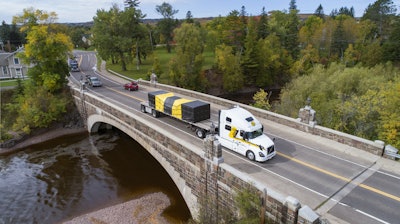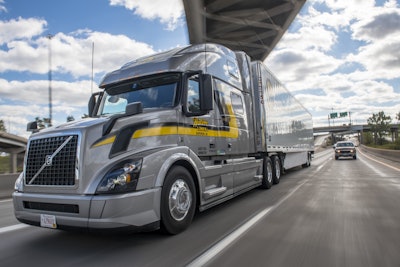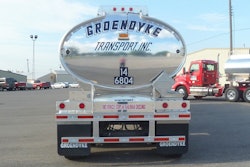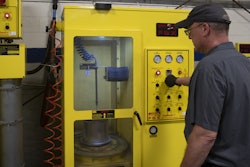![Halvor Lines- Bonnie 12[2]-2020-07-17-14-10](https://img.ccjdigital.com/files/base/randallreilly/all/image/2020/07/ccj.Halvor-Lines-Bonnie-122-2020-07-17-14-10-scaled.png?auto=format%2Ccompress&q=70&w=400)
CCJ Innovators profiles carriers and fleets that have found innovative ways to overcome trucking’s challenges. If you know a carrier that has displayed innovation, contact CCJ Editor Jason Cannon at [email protected] or 800-633-5953.
While on vacation this spring, Bonnie Ramsay was visualizing and connecting the dots of an electronic proof-of-delivery process in her mind.
Be the bill of lading. Be the truck driver. Be the receiver.
 Bonnie Ramsay, CIO of Halvor Lines, spearheaded the development of an electronic bill of lading to protect drivers at shipping and receiving locations.
Bonnie Ramsay, CIO of Halvor Lines, spearheaded the development of an electronic bill of lading to protect drivers at shipping and receiving locations.Ramsay, chief information officer of Halvor Lines, had left Superior, Wisconsin, March 5 to spend a week on a beach vacation with her husband. The coronavirus pandemic was in the early stages, and she became very concerned about the company’s 600-plus drivers.
“We had better come up with a way so that drivers don’t have to touch things — pens, paper, and maybe not even go into the building,” she was thinking.
She sketched out the plans for an electronic bill of lading (eBOL) and discussed them with Chris Bode, Halvor Lines’ in-house developer, as soon as she returned on March 18. The two promptly scheduled a conference call with three of Halvor’s technology vendors.
Ramsay had been discussing the potential disruptions of COVID-19 with colleagues since early February. “This is a scary thing,” she said. “What are we going to do if we have to send everybody home?”
In mid-February, she led the decision by Halvor Lines to purchase extra hardware and supplies to be able to send up to 50% of the office staff home if necessary. “I hope I am wrong about this,” she told co-workers.
It turns out she was right and during the vacation remained in constant contact with Halvor Lines’ systems engineer, who was setting up remote workstations. By the time she returned, 35% of the office staff was working from home.
Signatures at every stop
When the COVID-19 pandemic hit, Ramsay saw that drivers were at risk when picking up paper BOL documents at shipper facilities and handing them to receivers to sign within close proximity.
Drivers already were using a mobile app to capture and transmit pictures of signed BOLs to Halvor Lines’ back-office systems for use in payroll and invoicing. The eBOL would give drivers a new option to email documents to receivers to electronically sign at a safe distance.
Ramsay knew an eBOL could be developed with the cloud-based document management systems the company already used. She confirmed this during the conference call with the vendors by asking specific questions.
Besides using the mobile driver app, Halvor Lines also employs third-party applications for document management and electronic signature capture.
 The eBOL solution from Halvor Lines leverages an existing mobile driver app and tablet for drivers to request electronic signatures at delivery points.
The eBOL solution from Halvor Lines leverages an existing mobile driver app and tablet for drivers to request electronic signatures at delivery points.The vendors of each product began working on assigned tasks while Ramsay and Bode created functionality for the eBOL to support multi-stop deliveries.
Halvor Lines has flatbed, dry van, refrigerated and deck van operations. Multi-stop deliveries are common for its deck van shipments when drivers unload ATVs at dealerships.
For each stop, drivers need instant visibility of the status of a signed eBOL after sending the document to the receiver. Without a signature, the driver has not completed the freight transaction and cannot leave.
“Allowing [the eBOL] to function with multi-stop loads was a challenge, but when we figured how to do that, it turned out to be remarkably simple,” Ramsay said.
For the multi-stop deliveries and other functions to work properly, Halvor Lines needed its systems to automatically index and record the status of documents, starting at the moment a driver scans a paper BOL when picking up a load.
The eBOL uses custom code that Bode developed to index documents automatically, by type, when drivers capture them using the mobile app. The indexing process also matches documents to load numbers and other metadata.
Halvor Lines developed a web screen for the mobile driver app to display information about the driver’s trip and provide a menu of functions. When drivers arrive for a pickup, they enter their load number in the form and take a picture of the load documents.
As part of building the mobile form, Halvor Lines added metadata to retrieve the correct eBOL from its document management system for each delivery stop. Drivers use the menu to select the correct stop and the image of the eBOL they want to send to a receiver to sign. Next, they enter the name and email address of the signer.
Without the automated indexing and mobile form, drivers may not have the right document and information at their fingertips to send to the receiver to get a signature, Ramsay said.
Ready for prime time
Developing the eBOL with its vendor partners took several weeks. When completed, Halvor Lines tested the technology by rolling it out to individual drivers starting May 15. The strategy was to gain traction with a group of drivers before announcing it to the entire fleet.
 Halvor Lines has refrigerated, dry van, flatbed and deck van operations.
Halvor Lines has refrigerated, dry van, flatbed and deck van operations.Halvor Lines made a fleetwide announcement July 2 that the eBOL was available to drivers as an option. To help with the rollout, the company made a how-to training video that was sent to drivers using its learning management system from CarriersEdge that drivers can access through a separate mobile app on their tablets.
Halvor Lines uses a mobile driver app from Transflo on company-owned tablets. The images captured by drivers are sent to the document management system it uses from EBE Technologies. This system generates a PDF file from the captured image, which is linked to an electronic signature app from SignEasy through an application programming interface.
When drivers enter the signer’s email address, the PDF file is emailed to the signer through the SignEasy app, which walks the receiver through the signing process step-by-step. The receiver can sign by drawing or choosing a font and use a free-form text field to add notes to the BOL.
Once the eBOL is signed, the Transflo mobile app sends the document back to Halvor Lines’ electronic filing cabinet where it is picked up by EBE for use in the company’s payroll and billing system.
The custom code retrieves the signed BOL and updates the Transflo app to show the transaction has been completed, giving drivers an instant confirmation.
Geofencing is one of the future options that Halvor Lines is considering adding to the eBOL. When a driver arrives at a receiver, the eBOL could recognize the location and send the document automatically to the email address of the signer on file.
Another near-term possibility is offering the eBOL to partner carriers of Halvor Lines’ logistics division. Many already use the Transflo mobile app for capturing proof-of-delivery documents, Ramsay said.
At the moment, Halvor Lines has not talked to shippers about the eBOL, but Ramsay sees this as an opportunity for customers to send BOLs to the carrier electronically. The system could index them and automate the flow of documents to receivers.
Taking care of drivers
Ramsay gives credit to her co-workers at Halvor Lines and the company’s culture, which she describes as “like none other” as far as people treating each other with respect. The culture starts at the top with Chief Executive John Vinje and President Ryan Fraley.
 The eBOL solution developed by Halvor Lines is one of several mobile technologies that increase work conveniences for drivers.
The eBOL solution developed by Halvor Lines is one of several mobile technologies that increase work conveniences for drivers.“Both are incredibly considerate, kind and reasonable people,” Ramsay said. “They are very, very good people and bring it out in the rest of the group.”
Halvor Lines has been named a Best Fleet to Drive For by the Truckload Carriers Association seven years in a row. The eBOL is one of several technologies that give drivers added work conveniences. For example, drivers can use the SignEasy app on their tablets anytime they need to request a signature. An owner-operator recently used it to sign closing documents for a house.
Drivers also can access tractor permits, contact various departments and view the fleet’s fuel network by using the app, which gives drivers a ranking of prices, by location, to help owner-operators take advantage of fuel discounts.
Ramsay said her only motivation for developing the eBOL was to help driver co-workers, but the company also has been able to gain some efficiencies by getting a signed eBOL into its back-office systems immediately when drivers complete a delivery.
“If just one driver does not get sick because of utilizing this new tool, I’ve done my job,” she said. “I care for them so much and am so concerned for them out there right now.”











